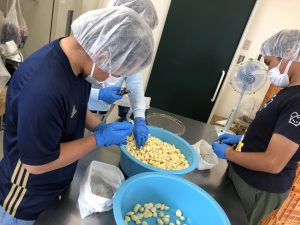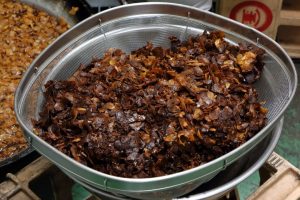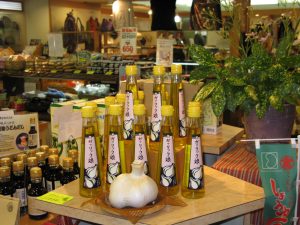地域から始まるローカルSDGs「ガァリック娘」で目指す地域課題の同時解決!/ Local SDGs in Action: “Garlic Musume” Tackles Community Challenges Head-On! / 从本地区开始的地方SDGs(可持续发展目标)“大蒜(Garlic)少女”以同时解决地区问题为目标
全国3位のにんにく生産量を誇る香川県。中でも琴平町では香川県産にんにくの中心的な産地として栽培が行われている一方、規格外で出荷されず、廃棄されるにんにくが年間約7トン発生していました。障がい者の雇用及び賃金アップを解決したい琴平町社会福祉協議会は、野菜を使った特産品の創出を目指す琴平町と連携し、同町内での商品開発への試みがスタートしました。
琴平町社会福祉協議会は、農商工連携にかかるマッチング活動をきっかけとして、生産者と協議を行い、形や大きさ、色など規格に満たず廃棄されるにんにくを市場価格より少し高い金額で買い取ることになりました。また、木のおもちゃ製作を主な事業としていた町内の障がい者福祉サービス事業所「ねむ工房」が、玉割り、皮むき、スライス、冷凍などの1次加工を担い、ガーリックオイルの地産地消を目指す高橋商店との連携でガーリックオイルが誕生しました。まずはサンプル品10kgの納品に向けて、町の調理室での試行がスタート。当初は障がい者に作業が担えるのか不安視する声もありましたが、丁寧かつ確実に作業を進める姿を見た担当者や生産者の確信を得るとともに、納品の品質もクリアし、100kg、200kgと受注量の増加につなげていきました。その後、調理室での製造では間に合わなくなったため「ねむ工房」の事業所内で、にんにく加工が行えるように整備されました。

にんにく成分を抽出する様子
障害のある方たちがにんにくの加工を行う上で、課題と感じていた手荒れや効率性に配慮し、玉ねぎの皮むき器を製造している会社に、にんにくの皮むき器のアレンジを依頼、また安全面から包丁の使用を避けるために、にんにくの根を切るステンレス性の爪切りのような道具を鉄工所に製作してもらうなど、多様な主体の協力を得ながら、設備等の整備を進めました。また、商品化に向けては、関係者が地元高校に出前授業に赴き、想いを伝えていたこともあり、デザイン科の生徒にネーミング・ラベル制作のアイデアを募り、ついにガーリックオイル「ガァリック娘」が誕生しました。一次加工を担う障がいを持った人たちに、工賃が支払われる仕組みが生まれたことで、地域の作業所での活動が生まれ、現在も8名の雇用が維持されています。結果として年間7トンほど発生していた食品ロスの削減にも寄与する結果となりました。

にんにくの根を切る作業
一方、「ガァリック娘」を製造する工程で、新たににんにくの残渣が2-3トン程、発生するようになっていました。オリーブオイルで加熱したにんにくを絞った後の残渣には風味や食味が残っていること、SDGsに取り組む企業から商品化に取り組みたいとの打診もあり、社会福祉協議会としても、8050問題や引きこもり、コロナ禍で働きたくても働けない人が柔軟に働ける場をつくりたいとの思いから、地産地消・アレルギー物質や添加物を使用していない商品として付加価値も確認した上で、2021年4月から新たな商品開発に取り組むこととなりました。

副産物となる残渣
この流れを受け、企業と社会福祉協議会に加え、にんにく生産者を交えた検討会が発足。油から残渣を引き上げた後の冷やす工程で、残渣が塊状に硬化し、粉砕が困難な副産物になることから、ガァリック娘の商品化にも関わった町内の鉄工所も協議の輪に加わりました。塊状に硬化した副産物を砕くための機械の試作や調整、意見交換、改善を繰り返す一方、企業では副産物の酸性劣化が進んでいないかの検証が進められました。5回の試行を繰り返し、ようやく機械が完成。再度、検討メンバーで工程の確認を行った結果、「粉砕作業→ふるい掛け作業→袋詰め作業」において長時間の作業が難しいことから、「ふるい掛け」の機械も製造し、残渣から新商品「どこでもガァリっ子」が誕生しました。商品開発、製造に関する一連の仕組みができたことにより、社会福祉協議会としても、更なる雇用を確保することができました。現在、「どこでもガァリっ子」は、地元の物産店、ホテルや旅館等の観光協会と商工会との連携により販売され、「ガァリック娘」を凌ぐ勢いで人気を集めています。両商品の販売で得らえた収益は、全て琴平町の地域福祉に還元されており、今後は、雇用を継続するための販売量増加を目標としています。

ガァリック娘販売の様子
地域の特産品を活用し、開発された「ガァリック娘」、「どこでもガァリっ子」。製造に携わるねむ工房はNPO法人格を取得。利用者は日々生き生きと加工に取り組んでいます。また、「どこでもガァリっ子」に携わる方たちの中には責任者を経て、イベントの接客ができるようになったメンバーもいます。関係者が出前授業で赴いた学校では、生徒がにんにくの植え付けや収穫作業等に参加、地域学習としての関わりも生まれています。福祉と環境、農業など多様な課題解決に向けた今後の取組にも注目です。
Local SDGs in Action: “Garlic Musume” Tackles Community Challenges Head-On!
Kagawa Prefecture boasts the third-highest garlic production in Japan, with much of that occurring in the town of Kotohira. However, every year about seven tons of garlic were simply being thrown out for failing to meet market standards. The Kotohira Council of Social Welfare, eager to provide employment opportunities and wage increases for people with disabilities, collaborated with the town of Kotohira, which was looking to create specialty products using vegetables, to begin an attempt at local product development.
The Kotohira Council of Social Welfare initiated talks with producers through matchmaking activities related to collaboration between agriculture, commerce and industry, and agreed to purchase garlic that would normally be discarded because it didn’t meet size, shape, or color standards for slightly higher than the market price. “Nemu Kōbō,” a local disability services and support organization that mainly manufactured wooden toys, took on the primary processing tasks such as splitting, peeling, slicing, and freezing. And, with the cooperation of Takahashi Shoten, which was aiming for local production and consumption of garlic oil, a new garlic oil was born. During the initial trial run, the goal was to deliver a 10 kg sample batch using the town’s kitchen. At first there was some concern about whether people with disabilities would be able to handle the work, but seeing their precise and reliable workmanship convinced the supervisors and producers alike, and the quality of the delivered product led to an increase in orders, eventually growing as large as 200 kg. As it became impossible to keep up while working out of the kitchen, Nemu Kōbō went so far as to outfit their own office with a garlic processing facility.

<Extracting Garlic Ingredients>
In order for people with disabilities to process garlic, and out of consideration for issues such as skin irritation and efficiency, a company that manufactures an onion peeler was asked to create a custom garlic peeler for them to use. Additionally, it was thought best to avoid knives for safety reasons, so an ironworks was commissioned to create a stainless steel tool similar to nail clippers for cutting garlic roots. In this way, improvements to the equipment were made with the help of various members of the community. As they prepared to bring the product to market, those involved with the project gave guest lectures at a local high school, sharing their thoughts and soliciting name and label ideas from the design department students, finally culminating in the creation of “Garlic Musume” garlic oil. With the advent of this system, where people with disabilities are paid wages to handle primary processing, there was an uptick in activity at local workshops, and even now eight individuals are maintaining their employment. It has also contributed to reducing the nearly seven tons of annual food loss mentioned earlier.

<Cutting Garlic Roots>
However, the Garlic Musume manufacturing process itself was producing around 2-3 tons of garlic residue. Realizing that this residue—which was left over after pressing garlic heated in olive oil—retained its flavor, there was a push by companies working on SDGs to find a way to commercialize it. The Council of Social Welfare also had an interest in establishing a flexible workplace to address the 8050 problem regarding middle-aged shut-ins living with elderly parents, as well as people who wanted to work but couldn’t due to the COVID-19 pandemic. After verifying the added value of a locally-produced, locally-consumed product with no allergens or additives, development of the new product began in April 2021.

<Residue Created as a Byproduct>
This led to the convening of a meeting between the companies, the Council of Social Welfare, and the garlic producers. To solve the problem of the residue hardening into difficult-to-break lumps after being removed from the oil and cooled, they enlisted the help of the same ironworks they worked with while developing Garlic Musume. Through repeated prototyping and revision, they developed a machine to break down the residue, while the companies determined whether or not it was undergoing acidic degradation. After five rounds of this, the machine was finally ready. The members from the previous meeting gathered again, this time confirming the difficulty associated with long hours of “crushing → sifting → packaging” operations. Consequently, a sifting machine was also manufactured, and the new product made from the garlic residue, “Dokodemo Garlikko,” was completed. The establishment of a complete system for product development and manufacturing allowed the Council of Social Welfare to secure additional employment opportunities. Currently, Dokodemo Garlikko is being sold with the cooperation of local shops, hotels and inns, tourism associations and chambers of commerce. Its popularity is growing rapidly, even surpassing Garlic Musume. All profits from the sale of both products are returned to the community welfare of Kotohira, with plans to increase sales volumes in order to provide continued employment opportunities.

ガァリック娘販売
<Garlic Musume For Sale>
“Garlic Musume” and “Dokodemo Garlikko” were developed from the region’s specialty products. Nemu Kōbō, involved in the manufacturing, has acquired NPO status. Every day, participants are energetically performing their work. And, among the those involved with “Dokodemo Garlikko,” some have even evolved into leaders adept at handling visitor interactions at events. At school visits by project members, students participate in garlic planting and harvesting, fostering community learning. This initiative stands out for its comprehensive approach, actively engaging with a broad spectrum of challenges beyond environmental sustainability, encompassing social welfare and agriculture as well.
从本地区开始的地方SDGs(可持续发展目标)“大蒜(Garlic)少女”以同时解决地区问题为目标
在以大蒜产量全国第三而闻名的香川县,琴平町一方面作为香川县大蒜的主要产地而栽培大蒜,另一方面,因为产品的规格未达到要求不能出货而被废弃大蒜每年有7吨。琴平町社会福利协议会为了解决残障人士就业和工资提高的问题,与以创造以蔬菜为原料的特色产品为目标的琴平町合作,开始在该町内进行商品开发的尝试。
琴平町社会福利协议会以农工商合作的对接活动为契机,与生产者进行协商,以略高于市场价的价格收购了因形状、大小、颜色等规格不合格而被废弃的大蒜。另外,以木制玩具制作为主要事业的町内残障人士福利服务事业所“NEME工房” 负责切分、削皮、切片、冷冻等的一次加工;在与以大蒜油的当地地产与消为目标的高桥商店合作基础上,创造出本地产的大蒜油。最初以10公斤样品为目标,在琴平町的厨房开始试制。起初也有人担心残障人士能否胜任这项工作,但是看到他们认真仔细地工作状态得到了该项目负责人和生产者的肯定,交货质量获得认可,订单量以100kg、200kg的速度不断增加。在这之后,由于在厨房中制造已经不足以满足订单量,NEMU工房的办公室也进行了能够进行加工大蒜的调整。

<提取大蒜成分的样子>
考虑到残障人士在加工大蒜的过程中会出现手湿疹和效率性的问题,所以委托生产洋葱削皮器的公司来设计大蒜削皮器。另外,从安全角度考虑,为了避免使用菜刀,在铁工厂的帮助下,制作了用于切断蒜根的像指甲剪一样的不锈钢工具,通过和各种机构的合作,推进设备的完善。另外,为实现商品化,相关人员还到当地高中进行授课,将相关的想法传递出去,并向设计科的学生征集命名和标签制作的想法,最终诞生了大蒜油“大蒜(Garlic)少女(商品名称)”。 在向负责一次加工的残障人士支付薪酬的制度诞生后,产生了在本地工作场所进行的活动,现在也维持着8人的雇佣。从结果来看,为减少每年产生的7吨左右的食品损失做出了贡献。

<切除蒜根的工作>
另一方面,在制造“大蒜(Garlic)少女”的工序中,又产生了2-3吨左右的大蒜残渣。用橄榄油加热的大蒜榨汁后的残渣还残留着蒜油的风味和大蒜的味道,也有致力于SDGs的企业提出要致力于商品化;社会福利协议会也提出了为解决8050问题(注:50多岁的拒绝与社会接触的子女由80多岁的高龄父母照顾的社会性问题)和拒绝与社会接触的人群,以及因为新型冠状病毒导致的想要工作而不能工作的人群创造能够灵活工作的场所,在确认了上述残渣有本地产消以及不添加过敏物质和食品添加剂的商品的附加价值基础上,从2021年4月开始了新商品的开发工作。

<作为副产品的食物残渣>
受此趋势影响,在企业和社会福利协议会的基础上,成立了大蒜生产者也加入的研讨会。由于残渣从油中提取后,经过冷却工序,会硬化成块状,成为难以粉碎的副产品,因此参与过“大蒜(Garlic)少女”商品化的町内铁工厂也加入了协商行列。在为了粉碎硬化成块状的副产物而反复进行机械的试制、调整、意见交换和改善的同时,在企业内部也在推进对副产物是否会酸性劣化的验证。经过5次反复试验,机器最终完成。讨论成员再次对工序进行了确认,结果发现“粉碎作业→筛选作业→装袋作业”的长时间作业很难,因此制造了“筛选作业”的机器,由此诞生了从残渣中提取新商品“到处都是蒜之子(商品名称)”。由于建立了商品研发、生产等一系列机制,社会福利协会也确保了更多的就业机会。现在,“到处都是蒜之子”由当地的物产店,酒店和温泉旅馆等观光协会和商工会联合销售,人气超过了“大蒜(Garlic)少女”。销售这两种商品所获得的收益将全部返还给琴平町的本地福利,今后的目标是为了继续雇用员工而增加销售量。

<贩卖大蒜(Garlic)少女的场景>
利用当地特产开发的“大蒜(Garlic)少女”、“到处都是蒜之子”,从事生产的眠工房(因此)取得了NPO法人(非盈利组织法人)资格。生产上述产品的人士每天都在积极地进行加工。另外,在参与“到处都是蒜之子”的成员中,也有一些成员经过担任负责人的工作,已经具备接待客户的能力。在相关人员前往授课的学校里,学生们参加了大蒜的种植和收获等工作,也产生了作为地区学习的关系。(大蒜(Garlic)少女)为解决福利、环境、农业等多种课题,今后将采取的措施也值得关注。



